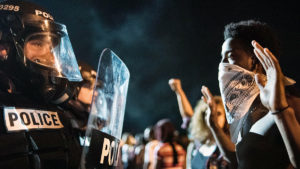I moved recently to a remote part of Northern California, where in a couple weeks an election will decide whether or not allies of the local militia take control of the county government. It’s a fraught situation, in a part of the country that’s often described by journalists, myself included, as being on the verge of civil war.
This can be a hard thing to explain. Just before I sat down to write this, I was at a bar where a liberal guy invited a not-so-liberal guy out to the parking lot. The liberal showed off a fly rod he’d built, and the redneck showed off a not-at-all-legal belt-loaded gun that he’d built. They came back smiling. Everyone mostly gets along fine. The incidents that seem to show overt cracks in the social order are very rare — occasional spats at restaurants or threatening visits to trailers, county board meetings moved online for safety.
They’re usually non-violent, and so wrapped up in the baroque Facebook-driven personal drama that colours life the rural American West these days that any honest observer has to wrestle with questions about whether or not they portend a real breakdown. The numbers of people involved are tiny. The divides aren’t really about Trump, race, class. They aren’t really about anything that fits into mainstream America’s understanding of why civil violence feels so possible in this country, unless you count the fact that basically everybody around here has guns.
Luckily, America has an influential class of professionals who make a living explaining situations like this. These are our extremism-watchers, and I should say here that I’m one of them. Today extremism-watching is a boom industry, and I was fortunate to have got in on it early, before Trump was elected, because now the race to establish yourself in the field can look frantic. The people who manage to do it tend to have long academic or government experience. The best way for them to get attention on Twitter and spots on NPR and cable news is by offering evidence that alarms the political and media class. And that class is naturally most alarmed by evidence that confirms its already-existing fears about what is going wrong in America.
The result is that there’s a very real professional incentive not to get to know your subjects too closely, lest you discover something that muddies up the story. And so the people who make the best living by describing America’s descent towards civil violence tend to be those with almost no personal knowledge of the armed rednecks they think are leading us there.
In this sense, Barbara F. Walter, author of a dire new book called How Civil Wars Start: And How to Stop Them, is extraordinarily well-positioned for success. This book, which came out January 11, has produced grimly portentous reviews in the Washington Post, the New York Times, and the Guardian. David Remnick, the editor of the New Yorker, warned Americans that “Like those who spoke up clearly about the dangers of global warming decades ago, Walter delivers a grave message that we ignore at our peril.”
But the book’s warning that America might be headed for a civil war isn’t what’s interesting about it. It seems unlikely that anyone reading this article hadn’t contemplated the possibility already. What’s interesting about the book is that it shows that something has gone deeply wrong with the systems of information that many Americans use to learn about their country. And that, in turn, is doing quite a lot to lead us towards civil war.
Back in November, before the book had come out and as she was getting the brand-building game going, Walter posted a Tweet. “The CIA actually has a Task Force designed to try to predict where and when political instability and conflict is likely to break out around the world,” she wrote. “It’s just not legally allowed to look at the U.S. That means we are blind to the risk factors that are rapidly emerging here.”
It was a bizarre thing to say. It’s true that the CIA is legally barred from this kind of activity in the United States, for reasons that probably don’t need to be explained. But that doesn’t at all mean that the US lacks a domestic intelligence or threat-assessment apparatus, as most people who deal with the fringe world of America’s militiamen, anarchists, and environmental activists will be very much aware. It makes sense to assume that Walter is aware of this too. So what is she getting at?
To see it, you have to understand how our internal intelligence-gathering apparatus really works. The important thing to grasp is that it’s a politically responsive system: During the George W. Bush administration, there was the period anarchists call the “Green Scare”, when Congress held hearings on “The Threat of Eco-Terrorism” and every anarchist gathering for a decade became fraught with fears of FBI infiltration.
This surveillance, and the arrests and wildly disproportionate prison sentences that followed, didn’t happen because the FBI’s organic threat-monitoring systems started noticing arsons in a few Western states. It was the result of an inflamed political narrative, fostered by business groups, that pushed the FBI to make radical environmental groups into its top enforcement priority. “You don’t have a bunch of companies coming forward saying I wish you’d do something about these Right-wing extremists,” one former FBI analyst told the Intercept later. “If enough people lobbied congresspeople about white nationalists and how it’s affecting their business activity, then I’m sure you’ll get legislation.”
It seems fair to assume that Walter understands how this works. She has spent decades researching civil conflict as a professor at UC San Diego, and makes much of her time serving on a CIA advisory panel called the Political Instability Task Force. Her first argument, drawing on data produced by the sorts of NGOs that gained an ever-more-prominent quasi-intelligence role in world affairs after the end of the Cold War, is that the potential for violence and political conflict in human affairs can be captured by data and predicted by experts like her. “Average citizens may not foresee civil war or who may start it,” she wants us to understand. “But experts who study civil war know where to look,” she says. “And it is often not the group most people would expect.”
Or is it? Walter offers a very assured-sounding analysis from an NGO called the Center for Systemic Peace, which ranks democracies on how stable their parties and elections are, among other factors, to show that America has become an “anocracy”, a state of government “somewhere between a democracy and an autocratic state”.
She believes very strongly in the judgments of NGOs and research panels, and she does not seem to have considered whether the worldview of the people who staff these groups might cause them to produce data that reinforces it. She offers their conclusions as fact: “We are no longer the world’s oldest democracy,” she writes. (People on the Right who think we’re ruled by an unelected administrative state will happily concur.) “We are no longer a peer to nations like Canada, Costa Rica, and Japan, which are all rated +10 on the Polity index.” Japan has been ruled almost continuously by the same insular party since 1955. But the numbers are the numbers.
It’s important that America has been deemed an anocracy, because anocracies are where most civil wars start, a fact that anyone who reads the foreign news section would already be aware of. And she cites a study of civil wars since 1800, which showed that in societies experiencing mass migration, immigrant groups were only half as likely as majority groups to launch a civil conflict.
This becomes a very important bridge in the book, suggesting that if we have a civil war it will surely be an ethnic one, organised in opposition to a diversifying America. The thesis of the book becomes that the entire Right-wing radical fringe is oriented around ethnic identity, and that ethnic resentments — organised by “ethnic entrepreneurs” like Croatia’s Franjo Tudjman, who helped kick off the wars in the dissolving Yugoslavia — are the source of most civil wars since the end of the Cold War.
Ethnic resentment only partly explains many major recent civil conflicts, including the wars in Libya and Afghanistan (both of which were instigated by US military action), but it will serve for ours. She suggests that by using phrases like “shithole countries” and proposing a wall, but also by pulling out of international agreements and starting a “trade war” with China, Donald Trump “did exactly what Tudjman did,” and “what Hutu extremists did when they characterised Tutsis as cockroaches and Hutus as the chosen people.” The Republican party itself, she says later, “has become like the Serbian Radical Party in Yugoslavia.” This is a party whose longtime leader was directly involved in ethnic cleansing.
It’s probably pointless to wonder whether saying Republican politicians act “exactly” like génocidaires is a meaningful way of looking at what’s happening in this country. Because this is how the extremism micro-industry’s incentive structure works: it would have been impossible for her to get a book deal, get reviewed, go on talk shows, get paid, and build a career had the situation not been dire and, to some degree, radically simplified.
But this simplification creates an epistemological problem. There is no incentive at all to feed America’s policymakers and media narrative-shapers information that doesn’t alarm them, or that would give them a complex moral picture of America’s radical fringe, which is overwhelmingly a rural phenomenon. Even if our urban thought leaders wanted to get a fair sense of what was going on in their restive hinterland, how could they get good information?
Walter’s suggestion is that they hire researchers and intelligence professionals who will approach the radical Right as if it were Isis or the Taliban. “If we are to avert civil war,” she writes, “we must devote the same resources to finding and neutralising homegrown combatants as we do to foreign ones.”
This sort of suggestion feeds what leftist critics call the “carceral” approach to counter-extremism research. Many Right-wingers now openly regard reporters and academics as out-of-uniform members of the intelligence apparatus, tasked with narrative creation and developing justifications for state repression. This means that researchers and journalists can often give up entirely on the project of trying to gain in-person access to these groups. As a result, we’re left with Walter’s data, leveraged to confirm her readers’ preconceptions. And so the cycle continues.
I happen to think that there’s a lot of white identity involved in the fringe politics of the county that I live in. But it’s not the organising force, and it would be dangerously naive to think that it was. Here there is a very totalising war of worldviews, touched off by the pandemic and resistance to expert advice and state action, led by a militia-aligned faction that thinks the local government betrayed the county’s free-living values by participating in California’s Covid protocols. Their liberal opponents often say that the “rugged individualism” driving the radicals is really just a cover for white supremacy.
There haven’t been any bombings or shootings, but there have been fights, and much of the local police force is more or less openly sympathetic to the radical faction. The Right in the county is now almost entirely alienated from the other structures of government, and it is hard to see how this situation could change, because many of the people involved in state and county government don’t actually see their concerns or worldview as democratically valid.
This is a good illustration of how analyses like Walter’s can become self-fulfilling. The paper here has mostly stopped reporting local news, and so many experts and officials have no way of knowing what’s going on — all they have are national narratives about Trump and demographic change that don’t actually explain the particular circumstances of the county. So the reactionary alienation grows deeper, the online threats get more serious, and the FBI has been showing up frequently to trailers and houses around the county. And, as the studies show, police crackdowns can often end up sparking insurgencies.
Disclaimer
Some of the posts we share are controversial and we do not necessarily agree with them in the whole extend. Sometimes we agree with the content or part of it but we do not agree with the narration or language. Nevertheless we find them somehow interesting, valuable and/or informative or we share them, because we strongly believe in freedom of speech, free press and journalism. We strongly encourage you to have a critical approach to all the content, do your own research and analysis to build your own opinion.
We would be glad to have your feedback.
Source: UnHerd Read the original article here: https://unherd.com




